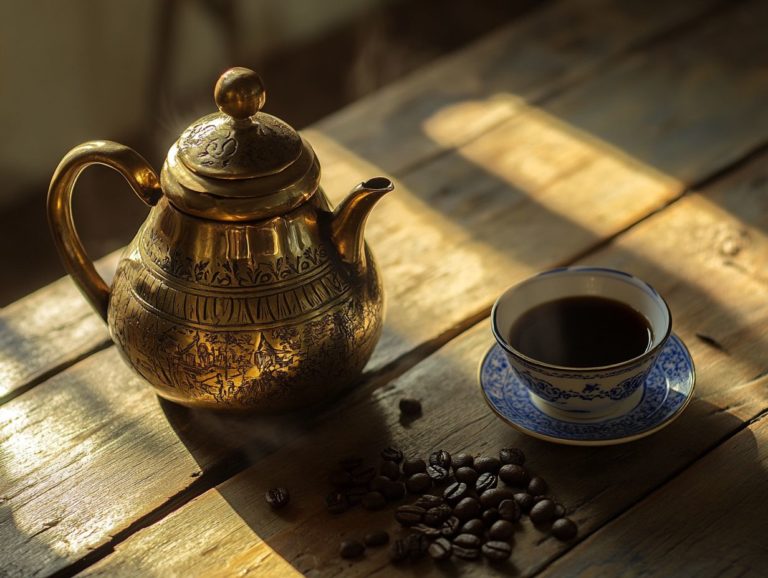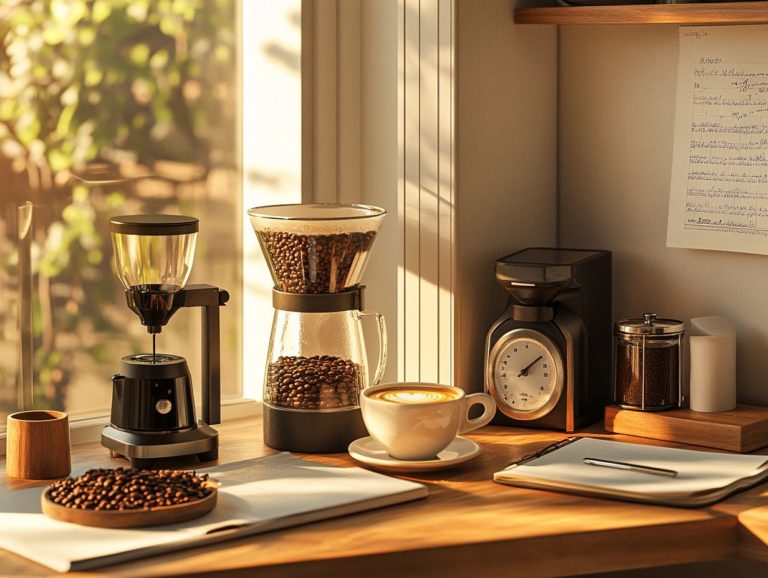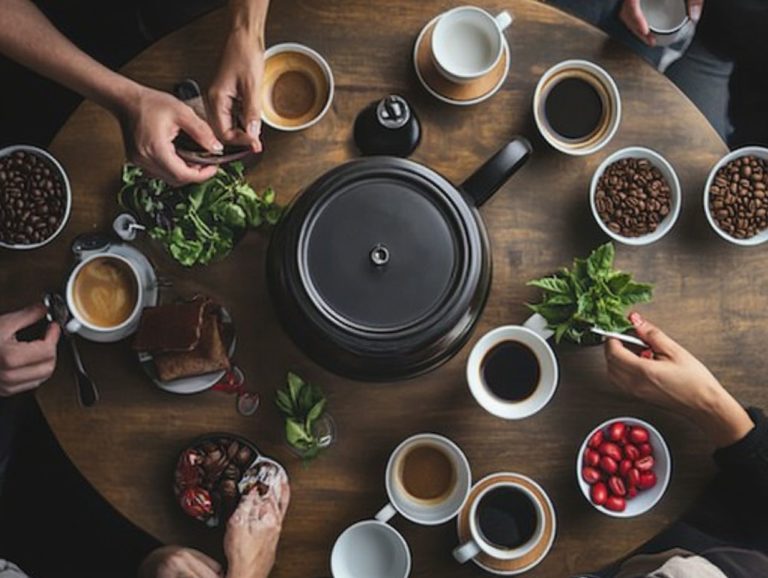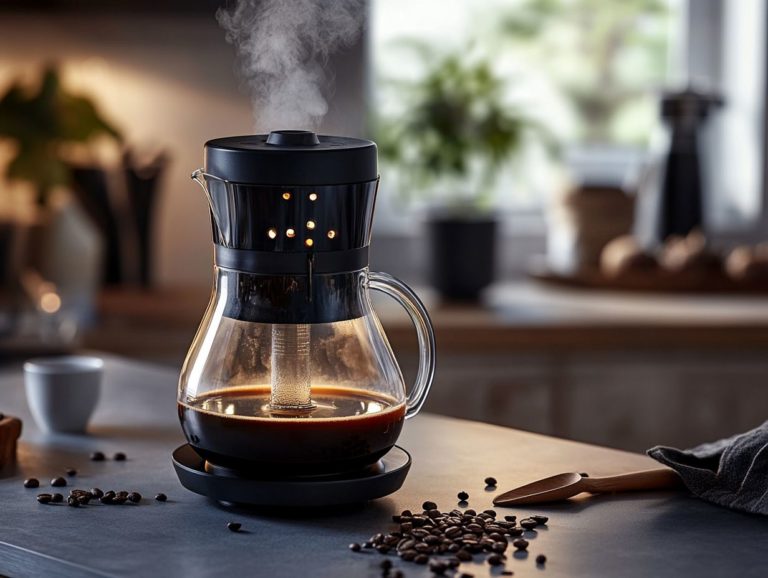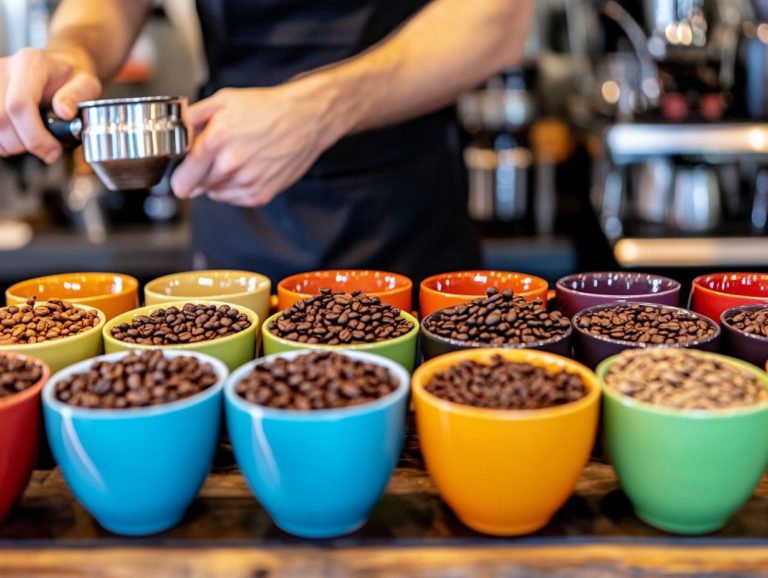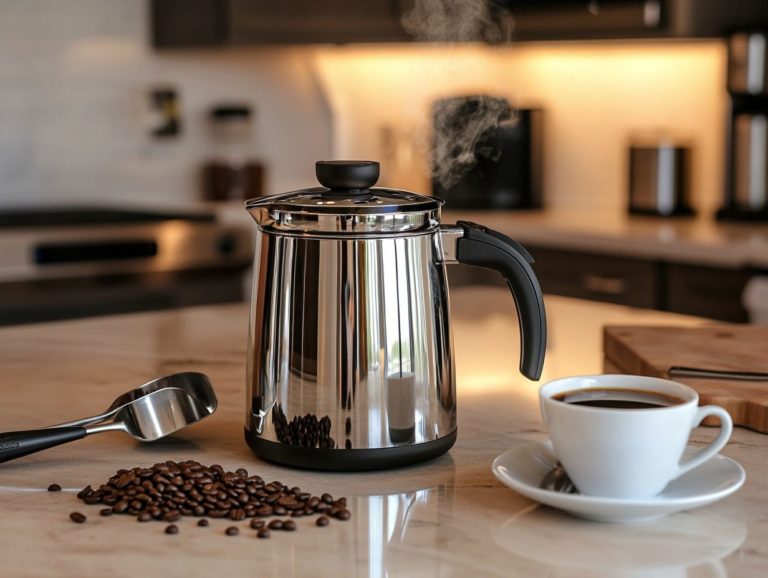Brewing Techniques: The Impact of Grind Size
The grind size of your coffee beans can significantly influence your brewing experience. From the extraction rate to the flavor profile, every nuance of your cup is determined by whether you choose a fine or coarse grind. The surface area of the coffee grounds plays a vital role in these brewing methods.
Whether you savor the boldness of a French press or the precision of a delicate espresso shot, understanding the different grind sizes and how they affect your brewing methods is essential for coffee lovers looking to enhance their brewing techniques.
This guide will help you select the ideal grind size, refine your technique, and elevate your home brewing experience to new heights.
Contents
- Key Takeaways:
- How Does Grind Size Affect Coffee Brewing?
- What Are The Different Types Of Grind Sizes?
- Choosing the Right Grind Size
- 3. Personal Preference
- How To Achieve The Perfect Grind Size?
- Frequently Asked Questions
- What is grind size and why is it important in brewing techniques?
- How does grind size impact the brewing process?
- What is the recommended grind size for different brewing methods?
- Can using the wrong grind size affect the taste of my coffee?
- Is there a way to control grind size without a coffee grinder?
- How often should I adjust my grind size for optimal coffee extraction?
Key Takeaways:
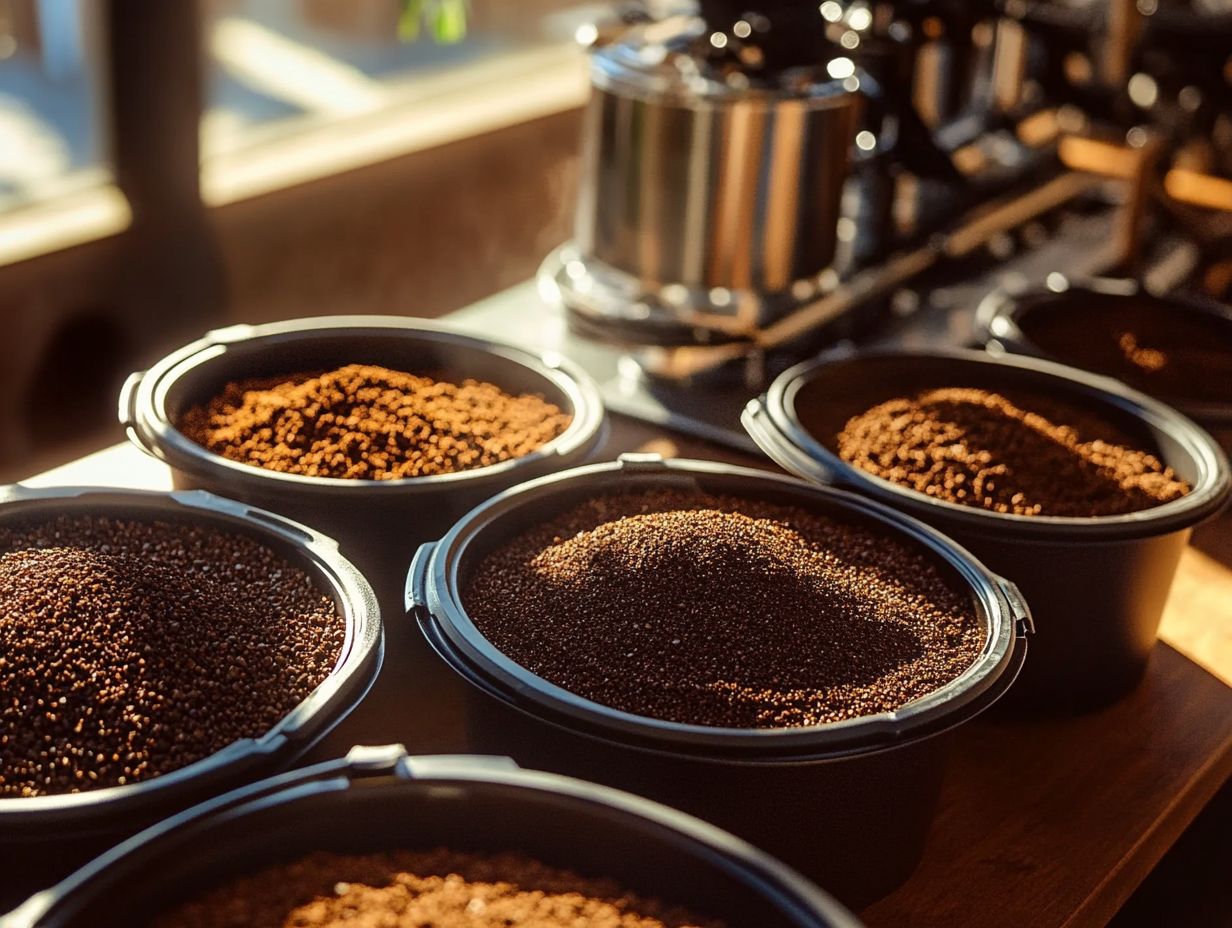
- The grind size of coffee affects the extraction rate, brew time, and flavor profile.
- There are six main types of grind sizes: coarse, medium-coarse, medium, medium-fine, fine, and extra-fine.
- When choosing the right grind size, consider the brewing method, coffee roast level, and personal preference.
How Does Grind Size Affect Coffee Brewing?
Understanding how flavors are pulled from coffee grounds during brewing is vital for anyone passionate about crafting the perfect cup. The grind size of coffee beans significantly influences this process, shaping both the flavor profile and your overall brewing experience.
Whether you lean towards a coarse grind for your French press or a fine grind for your espresso machine, the size of those coffee grounds directly affects the balance of aromatic and soluble compounds in your drink. Don t hesitate to tweak your grind size for an exciting flavor boost!
By experimenting with various grind sizes, you can tailor your coffee to your flavor preferences and elevate the quality of your brew, creating both strong coffee and light-bodied coffee to match your taste.
1. Extraction Rate
The extraction rate is a crucial aspect that influences how effectively flavors are drawn from coffee grounds during the brewing process. This can affect both the coffee flavor and the overall quality of the brew.
Different brewing methods and grind sizes significantly impact this rate. For example, using a coarse grind, like that of a French press, often leads to under-extraction, resulting in a brew that may taste weak and lack depth.
On the flip side, opting for a fine grind for espresso can enhance those rich flavors but poses the risk of over-extraction, where bitterness can overshadow the intended taste profile. This key balance between grind size and brewing underscores the importance of understanding how each approach affects extraction, guiding you on your journey toward the perfect cup of coffee.
Avoiding under-extraction is just as crucial; it can lead to a weak, watery brew that lacks depth. Start experimenting with grind sizes today to discover your perfect brew!
2. Brew Time
Brew time plays a crucial role in the coffee brewing process, and it s significantly influenced by the grind size of the coffee particles you choose. Different brewing methods will require specific grind sizes and brewing times to achieve the desired flavor sensations.
When you opt for a finer grind, you increase the surface area that comes into contact with water, allowing for quicker flavor extraction. This is why methods like espresso require a brief brew time, typically around 25 to 30 seconds. In contrast, if you prefer coarser grinds, which are perfect for brewing methods like French presses or cold brewers, you ll need to allow for longer contact with water to fully extract those desirable flavors often taking anywhere from four to twelve hours.
If you want to avoid a bitter taste, especially in espresso, it s essential to thoughtfully calibrate both the grind size and brew time. Balancing grind size and brew time helps you get the best flavor from your coffee. Using a good coffee kettle helps maintain a consistent water temperature, further enhancing your brew.
3. Flavor Profile
The flavor profile of your coffee is profoundly influenced by grind size, with the surface area of the coffee grounds playing a crucial role in flavor extraction. This also impacts the coffee aroma and overall brewing experience.
When you opt for a fine grind, you significantly increase the extraction rate, allowing for a bolder and more intense flavor to emerge. This results in those rich, robust brews that many enthusiasts cherish. On the other hand, coarser grinds provide a milder taste, often highlighting lighter notes that can accentuate the natural sweetness and acidity of the beans.
This variation opens up a world of experimentation for coffee lovers like you. By trying different brewing methods whether it’s a French press, espresso machine, or pour-over you can discover the ideal grind size that perfectly aligns with your personal preferences for aroma and flavor complexity.
What Are The Different Types Of Grind Sizes?
Grasping the various grind sizes is crucial for any coffee enthusiast seeking to elevate their brewing techniques and unlock the fullest flavor from their coffee beans. It s all about finding the right grind size that suits your coffee preferences and brings out the best in your brew.
Grind sizes typically span from coarse to fine, with each presenting distinct characteristics tailored to specific brewing methods like French press, espresso, pour-over, and cold brew.
The grind you choose significantly affects the extraction process, ultimately shaping the taste and aroma of your coffee experience.
1. Coarse Grind
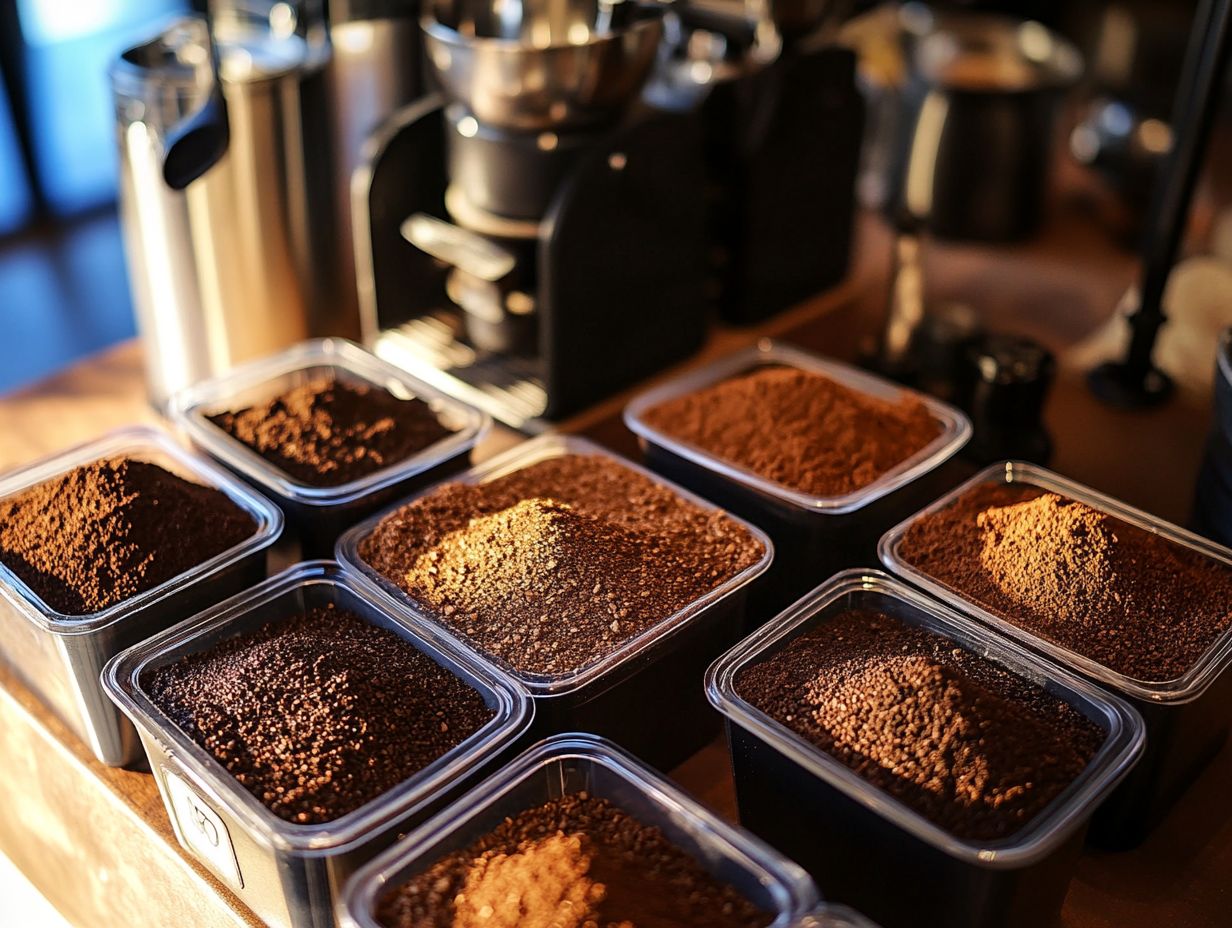
A coarse grind features larger coffee particles, making it the perfect choice for brewing methods like the French press and cold brew, where extended steeping times are essential. This grind size is also highly recommended by coffee experts for achieving a balanced extraction with these methods.
This grind size allows water to flow more freely around the coffee, promoting a balanced extraction that highlights the natural flavors of the beans. With its coarser texture, the risk of over-extraction leading to unwanted bitterness is significantly reduced, resulting in a smoother, more enjoyable taste. If you love a fresh coffee experience, this grind size is for you!
As the larger particles dissolve more slowly, they release their essential oils and flavors in a controlled manner, enhancing the overall profile of your coffee. If you love a rich, full-bodied brew, this method is perfect for you!
Try out different grind sizes and see how they change your coffee experience!
2. Medium-Coarse Grind
The medium-coarse grind strikes an exquisite balance between coarse and medium. It offers remarkable versatility for various brewing methods, including pour over and drip coffee. This grind is perfect for coffee enthusiasts who enjoy experimenting with different coffee varieties.
This grind size optimizes extraction. It reveals a rich yet nuanced flavor profile that highlights the intrinsic qualities of the coffee beans. The interaction between water and coffee creates a delightful brewing experience. Your brewed coffee retains its pleasant aromas and flavorful characteristics while avoiding excessive bitterness.
Whether you savor the bright acidity of lighter roasts or the deeper tones of darker varieties, a medium-coarse grind is an excellent choice. It promotes a well-rounded cup that caters to diverse palates, ensuring a satisfying experience with every sip.
3. Medium Grind
The medium grind is a favored choice among coffee enthusiasts. It serves as the standard grind size for drip coffee and many automatic brewing machines. It s also commonly used in self-service kiosks for its versatility.
This grind size strikes a perfect balance between fine and coarse textures. It is versatile enough to elevate various brewing methods, from pour-over to AeroPress. The medium grind optimizes water flow and extraction time, producing a rich and flavorful cup of coffee.
By allowing the water to interact with the coffee grounds for just the right amount of time, it maximizes the extraction of essential oils and flavors. This enhances your overall tasting experience. This balanced approach is perfect for coffee lovers who enjoy exploring the subtle flavors in each cup while ensuring that the coffee remains satisfying and avoids any unpleasant bitterness.
4. Medium-Fine Grind
The medium-fine grind is a go-to choice when using espresso machines. It provides the ideal surface area for extraction and enhances a rich flavor profile. It s also suitable for coffee drinkers using the Aeropress or pour-over methods.
This grind size perfectly balances being too coarse or too fine. It allows water to pass through quickly while maximizing contact time. When brewing espresso with this grind, it supports the development of complex tastes. This brings out sweetness and acidity without overwhelming bitterness.
You can also use it in various other brewing methods, such as Aeropress or pour-over, where a slightly quicker extraction is desirable. The characteristics of the medium-fine grind are crucial in the extraction process, ensuring effective interaction between water and coffee grounds.
The result is a well-rounded cup that showcases a delightful harmony of both bold and nuanced flavors.
5. Fine Grind
A fine grind is crucial for brewing methods like espresso. It requires a concentrated extraction to produce a robust cup of coffee.
The importance of a fine grind lies in its capacity to increase the surface area of the coffee grounds. This enables water to extract the rich flavors and aromatic compounds more effectively during brewing. This meticulous approach amplifies the flavor profile and ensures a delightful balance of sweetness and acidity.
However, achieving the perfect shot requires striking a delicate balance. Over-extraction can lead to unpleasant bitterness in your final cup. To avoid this pitfall, focus on maintaining precise brewing times, and adjust your grind size according to the specific beans and machines you’re using. Consulting coffee experts can provide valuable recommendations and help refine your technique.
6. Extra-Fine Grind
The extra-fine grind is your go-to for Turkish coffee. It requires an exceptionally fine particle size that elevates both the brewing process and the flavor profile. This grind size is essential for achieving the strong coffee and unique taste sensations that Turkish coffee is known for.
This meticulous grind ensures that the coffee grounds release their rich oils and aromatic compounds. As a result, you create a brew that is not only about taste but also about the entire experience.
To craft the perfect cup, you must master the art of coffee brewing. Striking a delicate balance between temperature and timing is crucial.
An expert brewer understands that applying just the right amount of heat prevents bitterness. This allows the sweet and spicy notes of the coffee to flourish and enhances the coffee flavor.
This level of skill transforms your coffee ritual into an exciting journey. Each sip becomes a true celebration of culture, tradition, and coffee aroma.
Choosing the Right Grind Size
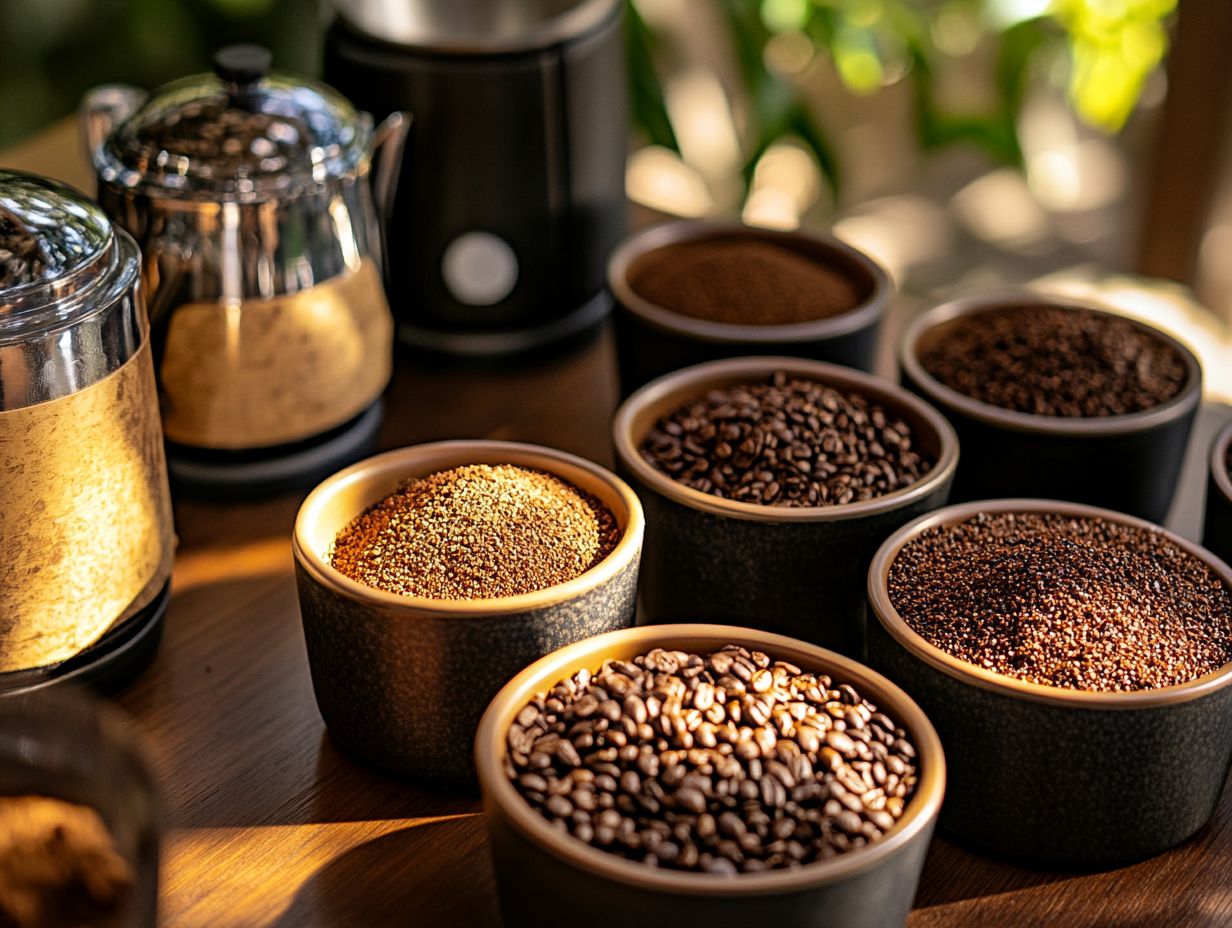
Selecting the perfect grind size is essential for any coffee enthusiast aiming to elevate their flavor profile and brewing experience. Considerations such as your brewing methods, the roast level of your coffee, and your individual taste preferences significantly influence the ideal grind size.
Understand these factors to enhance the extraction process and savor your coffee, from light-bodied coffee to strong coffee.
1. Brewing Method
The brewing method serves as a crucial factor in determining the right grind size. Each technique necessitates different particle sizes to achieve the best flavor extraction of soluble compounds.
For instance, when you opt for a pour-over method, a medium-fine grind is often your best bet. This grind size allows water to flow through the coffee grounds evenly, maximizing flavor extraction while avoiding the bitterness of over-extraction.
Similarly, the surface area of coffee particles plays a crucial role in this process.
On the other hand, when it comes to cold brew, you ll want a coarser grind. The longer brewing time at lower temperatures calls for larger particles, preventing excessive bitterness while allowing the vibrant, sweet notes to shine through in your cup.
Cold brew is a great way to explore different brewing techniques and flavor sensations.
By grasping these unique requirements, you enhance your skills as an aspiring barista and elevate your coffee experience as an enthusiast. This knowledge enables you to savor every sip with the precision and balance that truly defines a great cup of coffee.
2. Coffee Roast Level
The roast level of coffee beans plays a crucial role in shaping the flavor profile and can influence the ideal grind size for your brewing needs. Whether you prefer fresh coffee or aged beans, the roast level will guide your grind adjustments.
For example, light roasted beans often retain more natural acidity. A finer grind enhances extraction during brewing.
On the other hand, medium roasts strike a harmonious balance between acidity and a fuller body. This makes medium grind sizes suitable for a variety of brewing methods, ensuring that both brightness and depth of flavor are perfectly expressed. For those who enjoy experimenting, the medium grind works well with drip coffee and pour-over methods.
Dark roasts, known for their bold and intense flavor with reduced acidity, typically require a coarser grind to prevent over-extraction, which can result in unwelcome bitterness. Whether you’re using a French press or an espresso machine, understanding these subtleties will guide your grind adjustments.
By grasping these subtleties, you can make well-informed grind adjustments based on your roast preferences. Ultimately, this leads to a more enjoyable and flavorful cup of coffee.
3. Personal Preference
Personal preference plays an important role in determining the right grind size for your coffee, as each coffee lover possesses distinct tastes and desired flavor profiles. Whether you are brewing Turkish coffee or using a drip coffee machine, personal tastes must guide your choices.
You might find yourself drawn to different grind sizes based on your unique coffee experience perhaps you appreciate the bold intensity of a French press, or maybe you favor the delicate notes of a pour-over. By experimenting with various grind sizes, you can uncover how these subtle adjustments influence flavor extraction and enhance your overall enjoyment in that perfect cup.
It s a delightful journey of exploration that invites you to refine your brewing technique, balancing acidity and body in ways that truly resonate with your palate. Many coffee drinkers find this process helps them appreciate different coffee varieties.
Finding the ideal grind size can elevate your coffee into a masterpiece, bursting with the flavors that genuinely delight your senses.
How To Achieve The Perfect Grind Size?
Achieving the perfect grind size is an art that demands your careful attention and practice, ensuring optimal extraction that truly enhances the flavor of your coffee. Begin by investing in a quality grinder; it can significantly elevate the consistency and quality of your coffee grounds, whether you’re brewing at home or in a self-service kiosk.
Don t hesitate to experiment with various grind sizes, adjusting them based on your brewing method and personal taste. This exploration will enrich your coffee experience, transforming each cup into a delightful ritual. For the best results, always use fresh beans and consider a coffee subscription to ensure a steady supply of high-quality coffee.
1. Invest In A Good Grinder
Investing in a high-quality grinder is essential for any coffee lover eager to elevate their brewing experience and achieve the perfect grind size. When you have a reliable grinder at your disposal, you unlock the potential for a uniform grind, which is crucial for extracting the best flavors from your coffee beans. Coffee experts recommend burr grinders (which use two revolving abrasive surfaces) over blade grinders for more consistent results.
The grind size you choose directly influences your brewing methods, as different preparations require precision to achieve optimal taste. When you compare burr grinders to blade grinders, the differences in grind quality become clear: burr grinders provide a consistent and uniform size, resulting in a more balanced extraction, while blade grinders tend to produce uneven grinds, leading to bitter or weak coffee. This distinction is key to achieving the best coffee extraction and overall coffee quality.
Thus, making an informed choice about the type of grinder you use can significantly enhance the quality of your coffee experience. Investing in the right equipment transforms your home brewing setup into a self-service kiosk of high-quality coffee.
2. Experiment With Different Grind Sizes
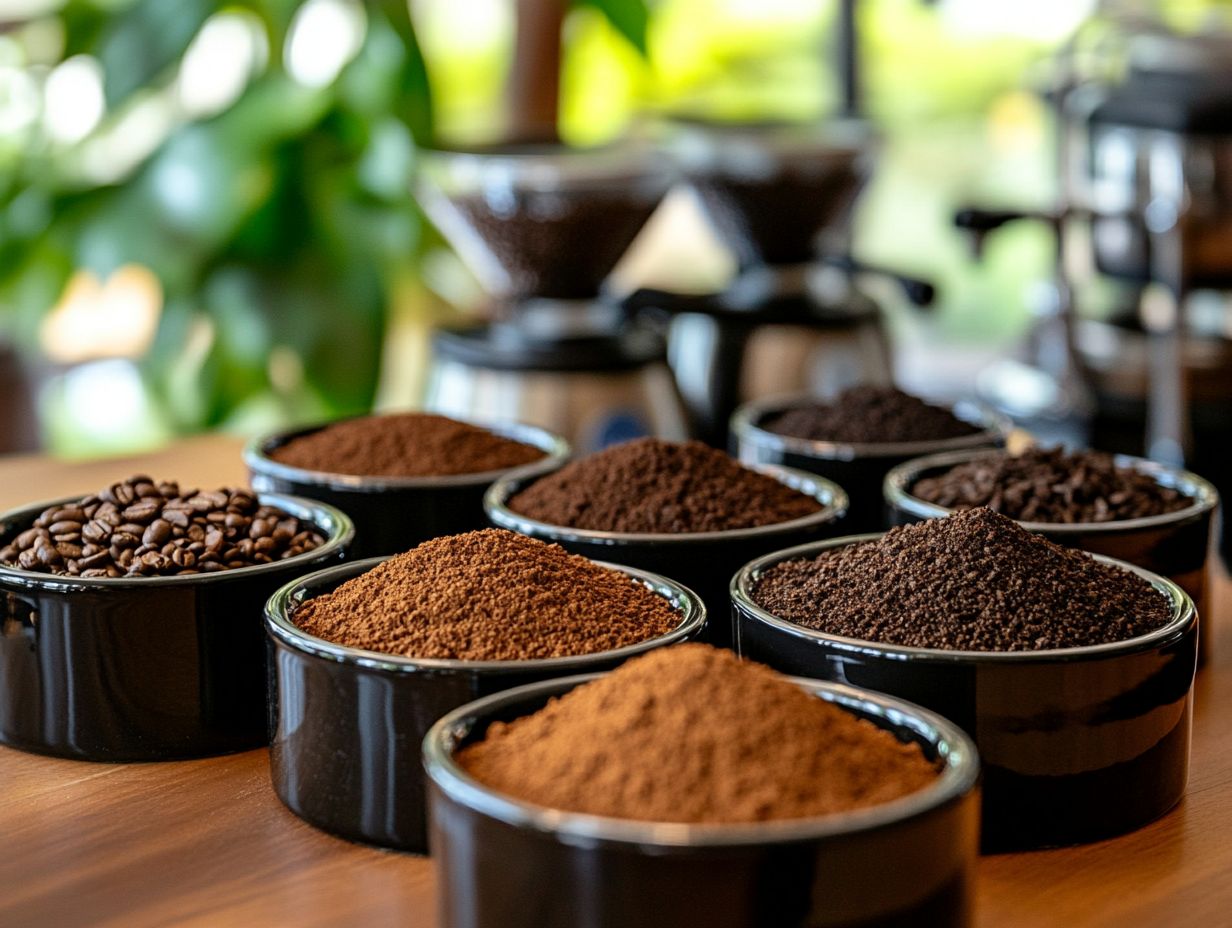
Experimenting with different grind sizes is an exhilarating journey for you as a coffee enthusiast, allowing you to uncover your perfect brewing method and flavor profile. Are you ready to discover your perfect flavor? Whether you prefer the bold intensity of an espresso or the delicate notes of a pour-over, the grind size is pivotal.
By adjusting the grind size, you can unlock a world of flavor sensations you may not have previously considered. Whether you opt for a coarse grind for a French press or a fine grind for espresso, each variation presents a unique tasting experience waiting to be explored. This process helps balance extraction, allowing you to find the perfect equilibrium between acidity and body.
Taking the time to record your trials thoughtfully will reveal unexpected nuances in the coffee’s taste, aroma, and body, enabling you to fine-tune your approach over time. This process of discovery not only elevates your coffee-drinking ritual but also deepens your understanding of how grind size interacts with water temperature and brewing time, ultimately leading to a truly personalized cup. This approach is especially beneficial for those who have specific brewing preferences or are exploring new coffee varieties.
In summary, understanding the importance of grind size and experimenting with it can significantly enhance your coffee experience. Start your journey today and unlock the full potential of every brew!
3. Adjust Grind Size As Needed
Adjusting the grind size as needed is a crucial aspect of your coffee brewing journey, allowing you to fine-tune extraction and elevate flavor to new heights. This practice is essential not only for achieving that delightful cup but also for embracing the unique characteristics of each coffee bean. Whether you’re aiming to avoid under-extraction or over-extraction, the right adjustments can make all the difference.
Different brewing methods call for specific grind sizes, and these choices can dramatically influence the overall taste profile. For example, a coarser grind may be perfect for your French press, yielding a robust and full-bodied brew, while a finer grind is a must for espresso, ensuring those rich, concentrated flavors are extracted to perfection. Additionally, the use of coffee kettles can help control water temperature, further refining your brewing process.
As a coffee enthusiast, it’s important for you to pay close attention to your brewing outcomes and personal taste preferences. Make small adjustments to the grind size when experimenting with various coffees. By monitoring extraction time and flavor notes, you can discern whether a coarser or finer grind produces the most satisfying cup, inviting you to dive deeper into your unique coffee experience. This attention to detail helps in achieving coffee recommendations that are personalized to your taste.
Frequently Asked Questions
What is grind size and why is it important in brewing techniques?
Grind size refers to the coarseness or fineness of coffee grounds, which affects the rate of extraction and ultimately, the flavor of the brewed coffee. It is an important factor in brewing techniques because a proper grind size can help achieve the desired taste and strength of the coffee. The right grind size can also influence the aroma intensity, adding another layer to your coffee experience.
How does grind size impact the brewing process?
The size of the coffee grounds affects the rate of extraction, which is the process of dissolving the flavor compounds from the beans into the water. A finer grind size increases the surface area of the coffee grounds, resulting in a faster rate of extraction. On the other hand, a coarser grind size slows down the extraction process. Understanding this balance is key to preventing both under-extraction and over-extraction.
What is the recommended grind size for different brewing methods?
The recommended grind size varies depending on the brewing method. For French press, a coarse grind is recommended, while a fine grind is suitable for espresso. Drip coffee typically requires a medium grind size. It’s important to adjust the grind size according to the brewing method to achieve the best flavor. Trying a coffee subscription service can also help you explore different grind sizes and coffee varieties.
Can using the wrong grind size affect the taste of my coffee?
Yes, using the wrong grind size can significantly impact the taste of your coffee. If the grind is too fine, it can result in over-extracted, bitter coffee. If it’s too coarse, the coffee may taste weak and under-extracted. It’s important to experiment with different grind sizes to find the perfect balance for your preferred taste. This level of precision can transform an ordinary cup into a truly special experience.
Is there a way to control grind size without a coffee grinder?
If you don’t have a coffee grinder, there are other ways to control grind size and maintain the quality of the coffee. For a fine grind, you can use a mortar and pestle to crush the beans into coffee grounds. To achieve a coarse grind, you can use a rolling pin or a hammer to gently crush the beans. However, using a coffee grinder will provide the most consistent and accurate grind size, impacting the flavor profile of your coffee.
How often should I adjust my grind size for optimal coffee extraction?
The frequency of adjusting your grind size depends on factors such as the type of beans, brewing method, and personal taste preferences. Different brewing techniques like French press, espresso machine, and pour-over require different grind adjustments. If you notice changes in the taste of your coffee, such as a bitter taste or a weak flavor sensation, it may be a sign to adjust the grind size. It’s also recommended to clean and reset your grinder periodically to ensure consistent grind size and to prevent issues like under-extraction or over-extraction, which can affect the balanced extraction and overall coffee flavor.

